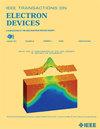在0.15- μ m的AlGaN/GaN HEMTs中,栅极凹槽结构的局部GaN帽刻蚀提高了高pae性能和陷阱分析
IF 3.2
2区 工程技术
Q2 ENGINEERING, ELECTRICAL & ELECTRONIC
引用次数: 0
摘要
本文全面研究了栅极隐切策略对用于高功率增加效率(PAE)应用的0.15- $\mu $ m氮化铝镓(AlGaN)/氮化镓(GaN)高电子迁移率晶体管(hemt)电学性能和陷阱动力学的影响。通过比较不同凹槽深度的设备和标准非凹槽对应的设备,我们系统地研究了设备性能和工艺引起的损伤之间的权衡。去除GaN帽的器件实现了1393 mA/mm的创纪录输出电流密度和661 mS/mm的峰值跨导,由于载流子浓度的增加和更高的${L}_{\text {g}}$ / ${t}_{\text {AlGaN}}$,缩短了短通道效应(SCEs)。值得注意的是,栅极凹槽器件在10 GHz时获得了最佳凹槽深度,PAE为81.6%,Pout为27.1 dBm。通过应力测量和射频跨导分析,我们量化了电感耦合等离子体(ICP)刻蚀引起的电流崩溃和边界陷阱的空间分布。结果表明,局部去除氮化镓帽提供了一种减轻损伤的途径来增强栅极控制,而过度的势垒稀释会降低2DEG浓度,加剧陷阱的形成,导致性能下降。这项工作通过平衡结构优势和工艺缺陷,为优化高频功率放大器的门凹槽设计提供了重要的见解。本文章由计算机程序翻译,如有差异,请以英文原文为准。
Localized GaN Cap Etching With Gate-Recessed Structure for Enhanced High-PAE Performance and Trap Analysis in 0.15- μ m AlGaN/GaN HEMTs
This article presents a comprehensive study on the impact of gate recessing strategies on the electrical performances and trap dynamics of 0.15- $\mu $ m aluminum gallium nitride (AlGaN)/gallium nitride (GaN) high-electron-mobility transistors (HEMTs) for high power-added efficiency (PAE) applications. By comparing devices with varying recess depths and their standard nonrecessed counterpart, we systematically investigate the trade-offs between device performance and process-induced damage. Device with GaN cap removal achieves a record output current density of 1393 mA/mm and a peak transconductance of 661 mS/mm, with reduced short-channel effects (SCEs) due to an increase in carrier concentration and a higher ${L}_{\text {g}}$ / ${t}_{\text {AlGaN}}$ . Notably, the gate-recessed device obtains an optimal recess depth with a PAE of 81.6% and Pout of 27.1 dBm at 10 GHz. Through stress measurement and RF transconductance analysis, we quantify the current collapse and the spatial distribution of border traps induced by inductively coupled plasma (ICP) etching. The results highlight that localized GaN cap removal offers a damage-mitigated pathway to enhance gate control, while excessive barrier thinning decreases the 2DEG concentration and exacerbates trap formation, leading to performance degradation. This work provides critical insights into optimizing gate-recessed designs for high-frequency power amplifiers by balancing structural benefits and process-induced defects.
求助全文
通过发布文献求助,成功后即可免费获取论文全文。
去求助
来源期刊

IEEE Transactions on Electron Devices
工程技术-工程:电子与电气
CiteScore
5.80
自引率
16.10%
发文量
937
审稿时长
3.8 months
期刊介绍:
IEEE Transactions on Electron Devices publishes original and significant contributions relating to the theory, modeling, design, performance and reliability of electron and ion integrated circuit devices and interconnects, involving insulators, metals, organic materials, micro-plasmas, semiconductors, quantum-effect structures, vacuum devices, and emerging materials with applications in bioelectronics, biomedical electronics, computation, communications, displays, microelectromechanics, imaging, micro-actuators, nanoelectronics, optoelectronics, photovoltaics, power ICs and micro-sensors. Tutorial and review papers on these subjects are also published and occasional special issues appear to present a collection of papers which treat particular areas in more depth and breadth.
 求助内容:
求助内容: 应助结果提醒方式:
应助结果提醒方式:


